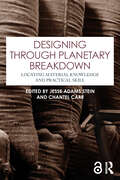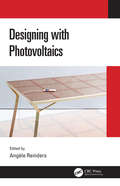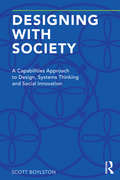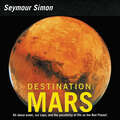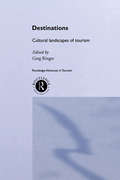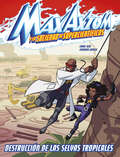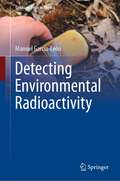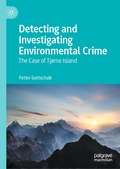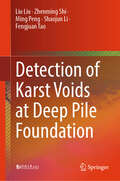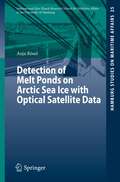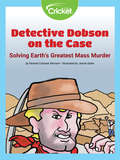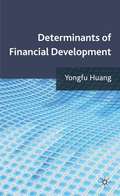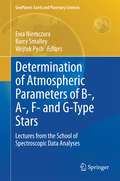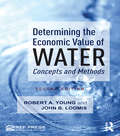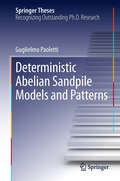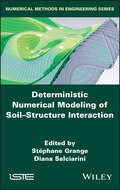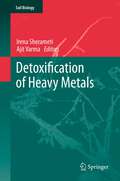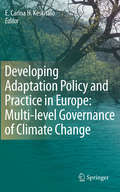- Table View
- List View
Designing the Forest and other Mass Timber Futures
by Lindsey WikstromIf we want to continue existing on this earth, an era of renewable energy and materials is urgently needed. What role could mass timber, with its potential to replace concrete and steel, have in ensuring the planet’s survival? This book retraces wood’s passage from stewarded seed in the soil of forests, to harvested biomass, to laminated walls in a living room, through to its disassembly, pausing at each step in the supply chain of mass timber to consider the labor and economies involved, looking closely at the way wood is grown, sourced, and transported, and its impacts on the biodiversity of the forest and the health of our ecosystems. It explores why historically entrenched contexts of extractivism make such sensitive approaches difficult to cultivate across landscapes and industrial frameworks. Along the way, common assumptions about mass timber are debunked, including its fire performance, its strength, and its role in carbon sequestration. Having identified contemporary technical, cultural, and spiritual gaps preventing the transition towards a fully timber built environment, it outlines how we might move forward. A more sensitive species-based methodology is essential, with designers as choreographers of carbon, transferring and trading between forest, factory, site, and beyond. This will be an important read for anyone interested in our built environment and how to design it to be non-extractive, especially those with an interest in architecture, urbanism, forests, ecology, and timber, as well as students of architecture and design interested in the generative nature of materials and design processes.
Designing the Megaregion: Meeting Urban Challenges at a New Scale
by Jonathan BarnettAs the US population grows—potentially adding more than 110 million people by 2050—cities and their suburbs will continue expanding, eventually meeting the suburbs of neighboring cities and forming continuous urban megaregions. There are now at least a dozen megaregions in the US, such as the one extending from Richmond, Virginia, to Portland, Maine, and the megaregion that runs from Santa Barbara through Los Angeles and San Diego, down to the Mexican border. In Designing the Megaregion, planning and urban design expert Jonathan Barnett takes a fresh look at designing megaregions. Barnett argues that planning megaregions requires ecological literacy and a renewed commitment to social equity in order to address the increasing pressure this growth puts on natural, built, and human resources. If current trends continue, new construction in megaregions will put additional stress on natural resources, make highway gridlock and airline delays much worse, and cause each region to become more separate and unequal. Barnett offers an incremental approach to designing at the megaregional scale that will help prepare for future economic and population growth. Designing the Megaregion explains how we can, and should, redesign megaregional growth using mostly private investment, without having to wait for large-scale, government initiatives and trying to create whole new governmental structures. Barnett explains practical initiatives for adapting development in response to a changing climate, improving transportation systems, and redirecting the forces that make megaregions very unequal places. There is an urgent need to begin designing megaregions, and Barnett offers a hopeful way forward using systems that are already in place.
Designing through Planetary Breakdown: Locating Material Knowledge and Practical Skill
by Jesse Adams Stein Chantel CarrIn an era of profound environmental and geopolitical uncertainty, Designing through Planetary Breakdown offers fresh perspectives on design’s evolving role in the face of planetary change. This unique collection emphasises practices and perspectives at the edges of conventional design, encompassing craft, material knowledge, repair, manual skills, creative practice and non-professional design, to reveal how design can address urgent challenges in grounded, hands-on ways.Structured into two sections – Skills and Capacities, and Care and Generative Practices – the chapters cover a rich range of topics examining both traditional and emerging approaches to making, caring and maintaining. Readers will find reflections on community-led adaptive urban heat strategies in Western Sydney, First Nations’ perspectives on design labour, repair-led design education initiatives, and the ethical and social dimensions of global supply chains. The book journeys through a wide range of empirical examples, including from Cuba, Indonesia, Spain and Australia, offering insights into generative transformations of materials and technologies. It demonstrates how design, expanded beyond the traditional professional confines, can foster practical responses to global issues.Designing through Planetary Breakdown is ideal for scholars, students, designers and craftspeople across design studies, design anthropology, repair and discard studies, craft studies and more broadly in the humanities and social sciences. Practical and deeply social, this collection offers a call to action: a guide for all hands to shape a future not just of survival, but of regeneration and collective action. The Introduction and Chapter 3 of this book is freely available as a downloadable Open Access PDF at http://www.taylorfrancis.com under a Creative Commons [Attribution-Non Commercial-No Derivatives (CC BY-NC-ND)] 4.0 license.
Designing with Photovoltaics
by Angèle Reinders"Designing with Photovoltaics" cover a broad range of topics related to the design of products, buildings and vehicles with integrated photovoltaic (PV) technologies including storage aspect. It enables the reader to easily design new products, buildings and vehicles through use of innovative PV products. Diverse categories of product integrated PVs are discussed including applications of solar power for mobility and building integrated systems along with design- and manufacturing-related information about solar cells. Illustrating design cases of various PV-powered products, special attention is paid to end-users and environmental aspects of PV applications. Aimed at senior undergraduates, graduates and professionals in electrical engineering, architecture, design, physics, mechanical engineering and those specifically studying photovoltaics, it Covers the different product integrated photovoltaics (PIPV) with a focus on design and manufacturing Presents comprehensive overview of all aspects of designing with photovoltaics Includes product integrated PV, building integrated PV and solar powered mobility concepts Contains real design cases showing how to design with photovoltaics Discusses context of environmental issues and user aspects
Designing with Society: A Capabilities Approach to Design, Systems Thinking and Social Innovation
by Scott BoylstonThis book explores an emerging design culture that rigorously applies systems thinking to the practice of design as a form of facilitating change on an increasingly crowded planet. Designers conversant in topics such as living systems, cultural competence, social justice, and power asymmetries can contribute their creative skills to the world of social innovation to help address the complex social challenges of the 21st century. By establishing a foundation built on the capabilities approach to human development, designers have an opportunity to transcend previous disciplinary constraints, and redefine our understanding of design agency. With an emphasis on developing an adaptability to dynamic situations, the cultivation of diversity, and an insistence on human dignity, this book weaves together theories and practices from diverse fields of thought and action to provide designers with a concrete yet flexible set of actionable design principles. And, with the aim of equipping designers with the ability to drive long-term, sustainable change, it proposes a new set of design competences that emphasize a deeper mindfulness of our interdependence; with each other, and with our life-giving natural systems. It’s a call to action to use design and design thinking as a tool to transform our collective worldviews toward an appreciation for what we all hold in common; a hope and a belief that our future is a place where all of humankind will flourish.
Destination Anthropocene: Science and Tourism in The Bahamas (Critical Environments: Nature, Science, and Politics #7)
by Amelia MooreDestination Anthropocene documents the emergence of new travel imaginaries forged at the intersection of the natural sciences and the tourism industry in a Caribbean archipelago. Known to travelers as a paradise of sun, sand, and sea, The Bahamas is rebranding itself in response to the rising threat of global environmental change, including climate change. In her imaginative new book, Amelia Moore explores an experimental form of tourism developed in the name of sustainability, one that is slowly changing the way both tourists and Bahamians come to know themselves and relate to island worlds.
Destination: Revised Edition
by Seymour SimonAward-winning science writer Seymour Simon explores the Red Planet through fascinating facts and amazing full-color photographs. Readers will learn about the recent discovery of water, the Valles Marineris—the biggest valley on Mars—the ice caps, recent expeditions, and more. This nonfiction picture book is an excellent choice to share during homeschooling, in particular for children ages 6 to 8. It’s a fun way to learn to read and as a supplement for activity books for children.This updated edition includes:author’s notestunning full-color photographsglossaryindexwebsites and additional reading sourcesSupports the Common Core Learning Standards, Next Generation Science Standards and the Science, Technology, Engineering, and Math (STEM) standards.
Destinations: Cultural Landscapes of Tourism (Routledge Advances in Tourism)
by Greg RingerThis book presents new directions both for tourism and cultural landscape studies in geography, crossing the traditional boundaries between the research of geographers and scholars of the tourism industry.Drawing on selected research from Europe, Southeast Asia, the Pacific and North America, the contributors combine perspectives in human geography and tourism to present cultural landscapes of tourist destinations as socially constructed places, examining the extent and manner by which tourism both establishes and falsifies local reality.The book addresses many critical themes which recent critiques in tourism studies focusing on the attitudes and behaviour of the tourist and on the industry as agents of social change have ignored, including the marginalization of the 'host' community, the privatization and commodification of local culture, and how tourism acts as both agent and process in the structure, identity and meaning of local places.
Destrucción de las selvas tropicales: una aventura de Max Axiom, supercientífico (Max Axiom y la sociedad de supercientíficos)
by Carol KimEn todo el mundo se talan árboles. Pero ¿por qué se talan los bosques lluviosos, y qué ocurrirá si se desaparecen? En esta novela gráfica de no ficción, Max Axiom y la Sociedad de supercientíficos tienen la misión de averiguarlo. Utilizando sus superpoderes y su superinteligencia, el equipo desglosará cada pieza de este complejo problema medioambiental en una aventura emocionante e informativas para que los jóvenes lectores puedan conocer las causas y los efectos de la deforestación y descubrir las medidas que todos podemos tomar para proteger estos frágiles ecosistemas.
Detecting Environmental Radioactivity (Graduate Texts in Physics)
by Manuel García-LeónThis textbook presents the principles and methods for the measurement of radioactivity in the environment. In this regard, specific low-level radiation counting and spectrometry or mass spectrometry techniques are discussed, including sources, distribution, levels and dynamics of radioactivity in nature. The author gives an accurate description of the fundamental concepts and laws of radioactivity as well as the different types of detectors and mass spectrometers needed for detection. Special attention is paid to scintillators, semiconductor detectors, and gas ionization detectors. In order to explain radiochemistry, some concepts about chemical separations are introduced as well. The book is meant for graduate and advanced undergraduate students in physics, chemistry or engineering oriented to environmental sciences, and to other disciplines where monitoring of the environment and its management is of great interest.
Detecting and Investigating Environmental Crime: The Case of Tjøme Island
by Petter GottschalkThis book discusses environmental crime and individual wrongdoing. It uses the theory of convenience throughout to examine financial motives, attractive opportunities, and personal willingness to explain deviant behavior. This book focusses primarily on the case study of the Island of Tjøme in Norway, an attractive resort where building permits were repeatedly granted to rich people in a protected zone along the shoreline. This book investigates how these crimes were detected and investigated by police over a few years with the help of whistleblowers. It discusses the interplay between the potentially corrupt public officials, professionals like architects and attorneys, and rich individuals, as an interesting and challenging arena for law enforcement. It covers attorneys’ defense strategies, evaluates private internal policing, and provides insights for those investigating individuals involved in environmental crime. It also examines the Vest Tank toxic waste dumping case and the resulting explosion where unusually both the chairperson and the chief executive were successfully sentenced to prison because of environmental crime, unlike many other environmental crime cases where individuals avoid prison. The case studies are drawn from Norway to supplement more well-known case studies from the USA.
Detection of Karst Voids at Deep Pile Foundation
by Zhenming Shi Ming Peng Liu Liu Shaojun Li Fengjuan TaoKarst voids at pile locations can have a significant negative impact on the bearing capacity and overall safety of cast-in-place pile foundations. This book introduces a state-of-the-art detection system, comprising of specialized equipment, algorithms, and software, designed to identify karst voids during deep cast-in-place pile foundation construction. The system includes a unique multifrequency borehole sonic probe, a single borehole radar, two pile hole sonar probes, and a corresponding signal analysis method. Several field and synthetic tests have been conducted to detect karst voids during cast-in-place pile foundation construction, and the results demonstrate that this technology can offer detailed geological information for pile design and ensure the safety of foundation construction. The work presented in this book has received the First Prize for Technological Invention in Shanghai, China in 2022.
Detection of Melt Ponds on Arctic Sea Ice with Optical Satellite Data
by Anja RöselThe Arctic sea ice is characterized by profound changes caused by surface melting processes and the formation of melt ponds in summer. Melt ponds contribute to the ice-albedo feedback as they reduce the surface albedo of sea ice, and hence accelerate the decay of Arctic sea ice. To quantify the melting of the entire Arctic sea ice, satellite based observations are necessary. Due to different spectral properties of snow, ice, and water, theoretically, multi-spectral optical sensors are necessary for the analysis of these distinct surface types. This study demonstrates the potential of optical sensors to detect melt ponds on Arctic sea ice. For the first time, an Arctic-wide, multi-annual melt pond data set for the years 2000-2011 has been created and analyzed.
Detective Dobson on the Case Solving Earth's Greatest Mass Murder
by Pamela Culshaw Harrison Janise GatesFollow Detective Dobson as he investigates Earth's greatest "mass murderer" that lead to the greatest extinction event in Earth's history nearly 250 million years ago. Dobson will travel the world investigating fossils- the evidence left behind by the killer that was left behind in the Earth’s crust. Who really was the killer? Was it a Volcano, Climate Change, Poisonous Gas? Help Detective Dobson find the real suspect with paleontology and geology! Will Dobson ever be able to truly find the killer?
Detectors, Reference Frames, and Time (Springer Theses)
by Alexander R. SmithThis thesis uses the tools of quantum information science to uncover fascinating new insights about the intersection of quantum theory and relativity. It is divided into three self-contained parts, the first of which employs detector models to investigate how the information content of quantum fields depends on spacetime curvature and global spacetime topology. The behavior of Unruh-DeWitt detectors on curved spacetimes are investigated, following which these detectors are used to probe the vacuum state of a scalar field in various topologies. This leads to a generalization of the entanglement harvesting protocol involving detectors in arbitrary curved spacetimes admitting a Wightman function. The second part extends the theory of quantum reference frames to those associated with noncompact groups. Motivated by the pursuit of a relational relativistic quantum theory where the group of reference frames is the Poincaré group, the author then generalizes a communication protocol between two parties lacking a common reference frame to the scenario where the group of transformations of their reference frame is a one-dimensional noncompact Lie group. Finally, the third part, inspired by theories of quantum gravity, generalizes the conditional probability interpretation of time, a proposed mechanism for time to emerge from a fundamentally timeless Universe. While the conditional probability interpretation of time is based upon conditioning a solution to the Wheeler-DeWitt equation on a subsystem of the universe that acts a clock, the author extends this approach to include an interaction between the system being used as a clock and a system whose evolution the clock is tracking.
Determinants of Financial Development
by Yongfu HuangA PDF version of this book is available for free in open access via the OAPEN Library platform, www. oapen. org. This book examines the emergence of both financial markets and carbon markets, and provides an in-depth investigation on the fundamental determinants of financial development.
Determination of Atmospheric Parameters of B-, A-, F- and G-Type Stars
by Ewa Niemczura Barry Smalley Wojtek PychThis book introduces the theory of stellar atmospheres. Almost everything we know about stars is by analysis of the radiation coming from their atmospheres. Several aspects of astrophysics require accurate atmospheric parameters and abundances. Spectroscopy is one of the most powerful tools at an astronomer's disposal, allowing the determination of the fundamental parameters of stars: surface temperature, gravity, chemical composition, magnetic field, rotation and turbulence. These can be supplemented by distance measurements or pulsation parameters providing information about stellar interior and stellar evolution, otherwise unavailable. The volume is based on lectures presented at the Wrocław's Spectroscopic School aimed at training young researchers in performing quantitative spectral analysis of low-, mid-, and high-resolution spectra of B, A, and F-type stars.
Determining the Economic Value of Water: Concepts and Methods
by Robert A. Young John B. LoomisWater provides benefits as a commodity for agriculture, industry, and households, and as a public good such as fisheries habitat, water quality and recreational use. To aid in cost-benefit analysis under conditions where market determined price signals are usually unavailable, economists have developed a range of alternative valuation methods for measuring economic benefits. This volume provides the most comprehensive exposition to-date of the application of economic valuation methods to proposed water resources investments and policies. It provides a conceptual framework for valuation of both commodity and public good uses of water, addressing non-market valuation techniques appropriate to measuring public benefits - including water quality improvement, recreation, and fish habitat enhancement. The book describes the various measurement methods, illustrates how they are applied in practice, and discusses their strengths, limitations, and appropriate roles. In this second edition, all chapters have been thoroughly updated, and in particular the coverage of water markets and valuation of ecosystem services from water has been expanded. Robert Young, author of the 2005 edition, has been joined for this new edition by John Loomis, who brings additional expertise on ecosystem services and the environmental economics of water for recreational and other public good uses of water.
Deterministic Abelian Sandpile Models and Patterns
by Guglielmo PaolettiThe model investigated in this work, a particular cellular automaton with stochastic evolution, was introduced as the simplest case of self-organized-criticality, that is, a dynamical system which shows algebraic long-range correlations without any tuning of parameters. The author derives exact results which are potentially also interesting outside the area of critical phenomena. Exact means also site-by-site and not only ensemble average or coarse graining. Very complex and amazingly beautiful periodic patterns are often generated by the dynamics involved, especially in deterministic protocols in which the sand is added at chosen sites. For example, the author studies the appearance of allometric structures, that is, patterns which grow in the same way in their whole body, and not only near their boundaries, as commonly occurs. The local conservation laws which govern the evolution of these patterns are also presented. This work has already attracted interest, not only in non-equilibrium statistical mechanics, but also in mathematics, both in probability and in combinatorics. There are also interesting connections with number theory. Lastly, it also poses new questions about an old subject. As such, it will be of interest to computer practitioners, demonstrating the simplicity with which charming patterns can be obtained, as well as to researchers working in many other areas.
Deterministic Numerical Modeling of Soil Structure Interaction
by Diana Salciarini Stéphane GrangeIn order to describe soil–structure interaction in various situations (nonlinear, static, dynamic, hydro-mechanical couplings), this book gives an overview of the main modeling methods developed in geotechnical engineering. The chapters are centered around: the finite element method (FEM), the finite difference method (FDM), and the discrete element method (DEM). Deterministic Numerical Modeling of Soil–Structure Interaction allows the reader to explore the classical and well-known FEM and FDM, using interface and contact elements available for coupled hydro-mechanical problems.Furthermore, this book provides insight on the DEM, adapted for interaction laws at the grain level. Within a classical finite element framework, the concept of macro-element is introduced, which generalizes constitutive laws of SSI and is particularly straightforward in dynamic situations. Finally, this book presents the SSI, in the case of a group of structures, such as buildings in a town, using the notion of metamaterials and a geophysics approach.
Deterministic, Stochastic, and Deep Learning Methods for Computational Electromagnetics
by Wei CaiThis book provides a well-balanced and comprehensive picture based on clear physics, solid mathematical formulation, and state-of-the-art useful numerical methods in deterministic, stochastic, deep neural network machine learning approaches for computer simulations of electromagnetic and transport processes in biology, microwave and optical wave devices, and nano-electronics. Computational research has become strongly influenced by interactions from many different areas including biology, physics, chemistry, engineering, etc. A multifaceted approach addressing the interconnection among mathematical algorithms and physical foundation and application is much needed to prepare graduate students and researchers in applied mathematics and sciences and engineering for innovative advanced computational research in many applications areas, such as biomolecular solvation in solvents, radar wave scattering, the interaction of lights with plasmonic materials, plasma physics, quantum dots, electronic structure, current flows in nano-electronics, and microchip designs, etc.
Detoxification of Heavy Metals
by Ajit Varma Irena SherametiHeavy metals are severe environmental pollutants, and many of them are toxic even at very low concentrations. With industrial development, soil pollution with heavy metal elements have dramatically increased. The uptake of heavy metals via plants that are exposed to contaminated soils is a risk for human health and a major hazard for the ecosystem as a whole, including soil microorganisms. On the other hand, plants may be used in the decontamination of soils. The topics presented in this book include: sources of heavy metals contaminants in soils; plant species that can grow on contaminated soils; the phytoremediation of contaminated soils; tolerance, accumulation and detoxification mechanisms of zinc, copper, arsenic, cadmium and vanadium in plants; the critical role of sulfur metabolism in heavy metal tolerance; the role of aquatic macrophytes, plant growth-promoting bacteria, sugar crops and earthworms in detoxification; and heavy metal stabilization by promoting zeolite synthesis in soils.
Deutschlands Energiewende – Fakten, Mythen und Irrsinn: Warum es immer schwerer wird, unsere Klimaziele zu erreichen
by Andreas LuczakSchon mehrere Jahrzehnte arbeitet Deutschland an der Energiewende, aber trotz gigantischer Kosten gehen die Treibhausgasemissionen viel zu langsam zurück. Bei diesem „Tempo“ wird die Klimaneutralität erst im nächsten Jahrhundert erreicht. Eine ausführliche Betrachtung der Thematik aus verschiedenen Perspektiven macht deutlich, dass die Energiewende nur ganzheitlich diskutiert werden kann und ein polarisierendes „schwarz-weiß-Denken“ uns nicht weiterbringt. Das Buch möchte eine Orientierung in dem komplexen Umfeld der Energiewende bieten und liefert Antworten auf Fragen wie diese: Welche Folgen hat die Energiewende für Deutschland? Wie sinnvoll sind Elektromobilität und Wasserstoffspeicher wirklich? Ist die Politik für Klimaschutz verantwortlich oder rettet nur persönlicher Verzicht das Klima? Die 2., aktualisierte Auflage.
Deutschlands Norden: vom Erdaltertum zur Gegenwart
by Margot Böse Jürgen Ehlers Frank LehmkuhlDieses Sachbuch erklärt die faszinierende Entstehung der heutigen Landschaft im Norden Deutschlands. Das Ziel ist es, in einer integrativen Betrachtungsweise geowissenschaftliche, archäologische und ökologische Forschungsergebnisse zusammen zu führen und vielfältige Veränderungen des Naturraumes durch den Menschen darzustellen. Für die neue Auflage wurden daher etliche Kapitel grundlegend überarbeitet und ergänzt und es wurden neue, spannende Exkurse eingefügt. Im ersten Teil beschreiben die Autoren die Geologie des Untergrundes und die später durch den Menschen genutzten Rohstoffe, vornehmlich Salze und Kohle. Auch die Klimageschichte spielt eine wichtige Rolle bei der Landschaftsentwicklung, daher werden dem Leser einige gängige Forschungsmethoden für die eiszeitlichen und nacheiszeitlichen Klimaveränderungen vorgestellt. Im nächsten Teil des Buches wird auf die verschiedenen rezenten Natur- und Landschaftsräume mit ihren spezifischen Oberflächenformen eingegangen: die unterschiedlichen Küsten von Nordsee und Ostsee, die ehemals vergletscherten Moränenlandschaften der quartären Vereisungen, die Mittelgebirge Harz und Eifel und die großen Flusssysteme. Am Ende des Buches zeigen die Autoren auf, wie der Mensch die Landschaft in den letzten 7.500 Jahren genutzt und damit umgestaltet hat. Abschließend wird ein Überblick über die aktuellen Maßnahmen zum Schutz der Landschaft und zum Erhalt der ökologischen Vielfalt gegeben. Das reich bebilderte, anschauliche und zum Stöbern einladende Buch ist eine erweiterte und ergänzte Auflage und liefert mit seinen Schwerpunkten: · Einen tiefen Einblick in die spannende Geschichte der Landschaft im Norden Deutschlands. · Eine fundierte Beschreibung der einzelnen Landschaftsräume und deren Entstehung. · Aktuelle Forschung zur Prägung und immer weiter zunehmenden Veränderung der Umwelt durch den Menschen seit Beginn der Jungsteinzeit. Als Leser möchten wir Studierende, Lehrende und aber auch gerade interessierte Laien gewinnen, die sich für Norddeutschland als Natur- und Kulturraum interessieren. Daher ist das Buch sprachlich so abgefasst, dass es einen breiten Leserkreis anspricht.
Developing Adaptation Policy and Practice in Europe: Multi-level Governance of Climate Change
by E. Carina KeskitaloMitigation will not be sufficient for us to avoid climate change and we will need to adapt to its consequences. This book targets the development of adaptation policy in European countries with different relations between central and regional/local government.


